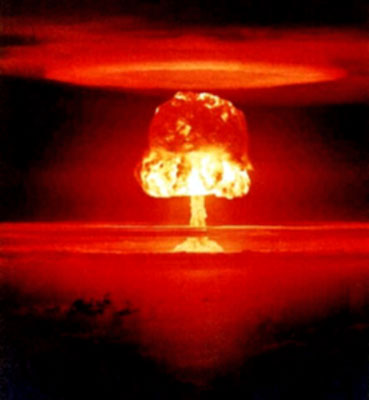
by Sherwood Ross
March 27, 2012
from
GlobalResearch Website

U.S. corporations that reap billions from making nuclear weapons have "a
direct voice" as to "their use and deployment," according to professor
Michel Chossudovsky in a recently released book.
What's more, he says, if nuclear weapons are integrated with conventional
armaments, a decision to use nuclear weapons could be made by battlefield
generals.
On August 6, 2003, on Hiroshima Day, (August 6 1945), a secret meeting was
held at U.S. Strategic Command headquarters at the Offutt Air Force Base,
Omaha, Neb., that brought together more than 150,
"senior executives from the nuclear industry
and military-industrial complex," writes Michel Chossudovsky, Director
of the Centre for Research on Globalization (CRG) in Montreal.
"This mingling of defense contractors, scientists and policy-makers was
not intended to commemorate Hiroshima".
According to a leaked draft of the agenda, the
secret session included discussions on "mini-nukes" and "bunker-buster"
bombs with nuclear warheads,
"for possible use against rogue states,"
Chossudovsky writes in his new book, "Towards
a World War III Scenario: The Dangers of Nuclear War."
(Global Research, 2012)
The meeting was intended to set the stage for
the creation of a new generation of,
"smaller," "safer," and "more usable" nukes
for use, in America's 21st Century "in-theater nuclear wars",
Chossudovsky writes.
No members of Congress representing the public
were in attendance.
Barely a week prior to this meeting, the National Nuclear Security
Administration (NNSA) disbanded the advisory committee that had
"independent oversight" over the U.S. nuclear arsenal, including the testing
and/or use of new nuclear devices.
The nuclear industry - which makes both nuclear devices and their missile
delivery systems - Chossudovsky writes, is controlled by a handful of
defense contractors, led by,
-
Lockheed Martin
-
General Dynamics
-
BAE Systems Inc
-
Northrop Grumman
-
Raytheon
-
Boeing
The
sales of these six largest US defense
contractors (including the UK-US conglomerate BAE Systems Inc) was in 2010
of the order of 242.6 billion dollars, with recorded profits of $16.4
billion.
Meanwhile,
"the Pentagon has unleashed a major
propaganda and public relations campaign with a view to upholding the
use of nuclear weapons for the 'defense of the American homeland',"
Chossudovsky writes.
He points out:
"In an utterly twisted logic, nuclear
weapons are presented as a means to building peace and preventing
‘collateral damage.’ The Pentagon had intimated that the ‘mini-nukes’
with a yield of less than 5,000 tons are harmless to civilians because
the explosions ‘take place under ground.’
Each of these ‘mini-nukes,’ nonetheless,
constitutes - in terms of explosion and potential radioactive fallout -
between one-third and six times the atom bomb dropped on Hiroshima in
1945."
WWIII Scenario
Based on the twisted notion that the,
"mini-nukes" are "not dangerous for
civilians," the U.S. Congress in 2003 gave the Pentagon the "green
light" to use tactical nuclear weapons in "conventional war theaters"
(such as the Middle East and Central Asia) alongside conventional
weapons, Chossudovsky writes.
This new nuclear doctrine, he goes on to say,
turns reality upside down not only by denying the horrific impact of nuclear
weapons but by asserting,
"in no uncertain terms that nuclear weapons
are 'safe' and their use in the battlefield will ensure 'minimal
collateral damage' and reduce the probability of escalation."
Chossudovsky notes,
"The issue of radioactive fallout is not
even acknowledged with regard to tactical nuclear weapons; neither is
the issue of 'Nuclear Winter'."
To justify pre-emptive military actions,
U.S. National Security Doctrine (NSD) requires the fabrication of a terrorist, or
"outside enemy," threat, the author writes.
As well, the doctrine needs to tie said
terrorist threats to "state sponsorship" by so-called rogue states. Here,
the
Global War on Terror (GWOT) directed
against Al Qaeda fits right in as essential building blocks in the
Pentagon’s GWOT campaign.
Under the latest nuclear doctrine, the Pentagon discards the policy of
fighting in "self-defense" in favor of "anticipatory action."
This war would allow the use of nuclear weapons
against a "rogue enemy" who is alleged to plan to develop WMD at some
undefined future date, Chossudovsky writes.
"Nukes would serve to prevent a non-existent
WMD program (e.g. Iran) prior to its development," the author explains.
"This twisted formulation goes far beyond
the premises of the 2001 Nuclear Posture Review and NPSD 17, which state
that the U.S. can retaliate with nuclear weapons if attacked with WMD."
And by integrating nuclear with conventional
armaments on the battlefield,
"there is the risk that tactical nuclear
weapons could be used without requesting... presidential approval,"
Chossudovsky writes.
He asserts,
"combat commanders would be in charge of
Theater Nuclear Operations (TNO), with a mandate not only to implement
but also to formulate command decisions pertaining to nuclear weapons."
Moreover, because these "smaller" tactical
nuclear weapons have been reclassified by the Pentagon as,
"safe for the surrounding civilian
population," thereby allegedly "minimizing the risk of collateral
damage," there are no overriding, built-in restrictions to prevent their
use, Chossudovsky writes.
Stockpiled tactical nuclear weapons, he
concludes, are now considered to be an integral part of the battlefield
arsenal, "part of the tool box," so to speak, used in conventional war
theaters.

